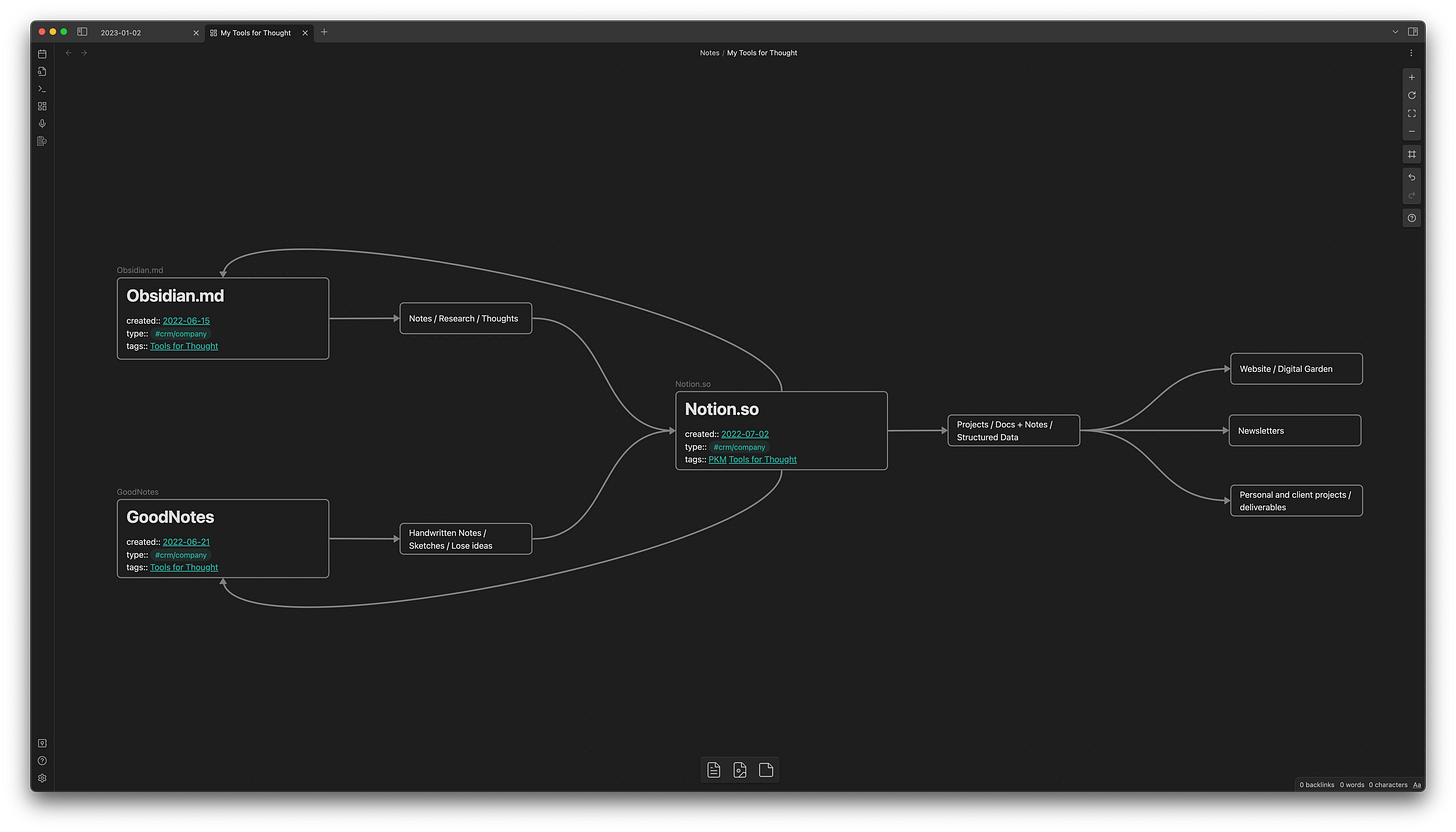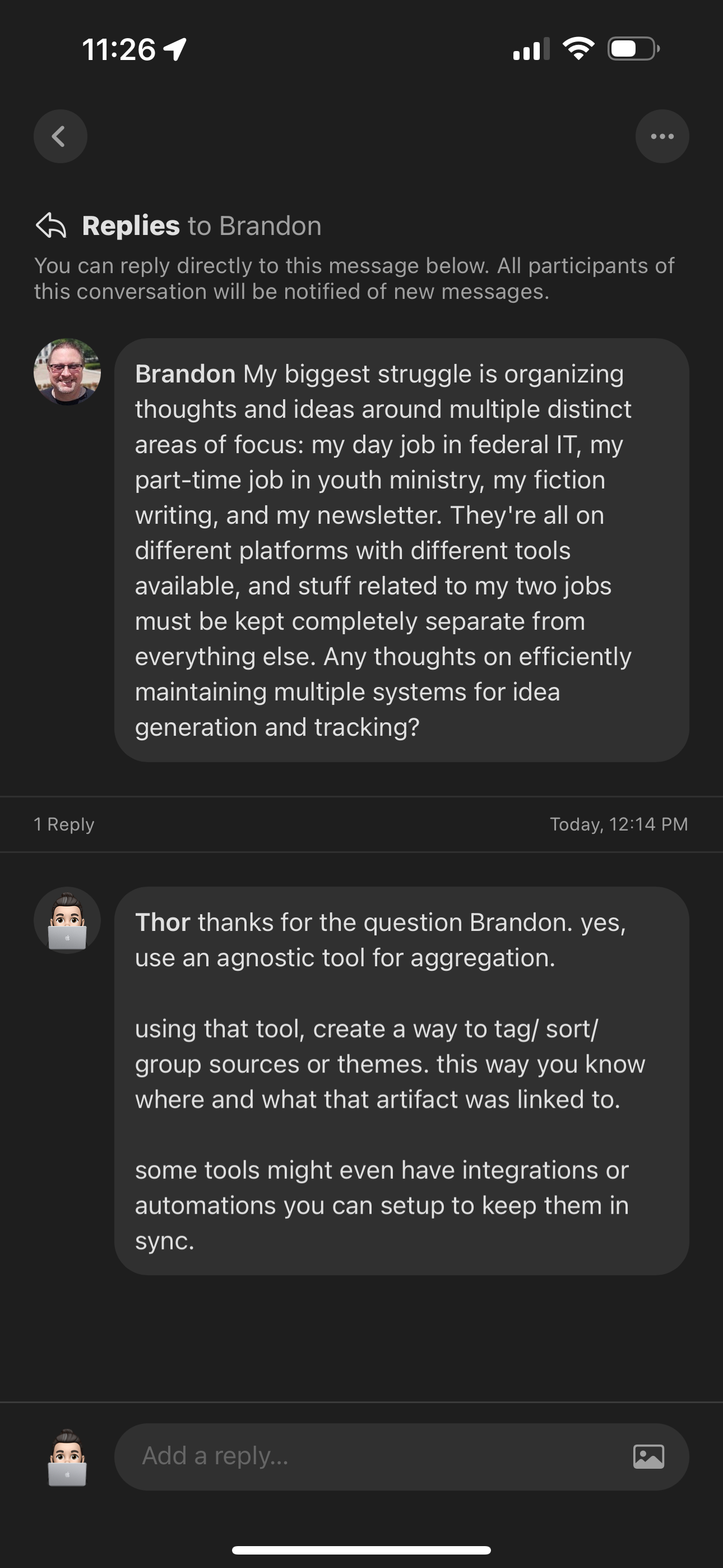Over the last few editions, I have written a lot about note-taking. I touched on the different styles of note-taking and how cognition is impacted by augmenting our minds. Today’s edition goes further into the tools I use for note-taking and thinking.
These tools broadly fall into a category called tools for thought. What are tools for thought? I define them as tools to allow for more efficient and deeper thinking.
I have tried a lot of these tools. They come in the form of apps and websites. They all make you feel like you are going to 10x your productivity by using them. And while some of them can really augment your mind, most don’t, unless you have systems that work for you.
I am a digital operations consultant by trade, so understanding various tools and systems is kind of my thing. I am not going to get into most of them and this is not a tool versus tool showdown, this is my real-world experience using tools that genuinely impact how I think.
So which tools are on the menu today? Notion, Obsidian, and GoodNotes.
For each tool, I will explain the following:
The basic features and use cases
How long I have been using them to date
How I use them
How they augment my thought
Why I use them over other options out there + cost
I will then let you know how they fit into my system holistically.
Notion
Notion is slowly becoming one of the most ubiquitous tools for thought. If you don’t know much about it, Notion is marketed as an all-in-one workspace. It is much more than that though. It is a tool for building solutions. Some of those solutions could be note-taking, task management, project management, web clipping, etc. Notion is a web-first app, that has desktop and mobile applications. These apps are electron based, so they are basically web apps on your devices. It is free for most use cases, though they do offer paid plans if your needs outgrow their free plan.
I have been using Notion since 2019. As of today, I am a Notion Ambassador and Certified Notion Consultant. So I use Notion to build things for other people and companies. Setting that aside, my use cases have changed a lot through the years, but have always been rooted in the concept of a unified second brain.
As my second brain, Notion has stored notes, tasks, and very custom workflows for me. At the moment I am mainly using it for managing all projects, personal or client based. My website is also built using it. I have systems for managing fitness training, financial records, and even my digital garden. Notion has replaced, nearly, every need for Google Docs or similar tools.
My digital garden just went live on Notion’s template gallery → Check it out
Notion augments my thoughts by allowing me to keep most of my data in one home. This limits my need to context switch which keeps me focused. It also keeps information up to date, not allowing for duplicates. There is also a basic form of networked thought using backlinks. Where Notion really shines, and the main thing that attracts me to it, is the ability to structure and relate my data, using databases. This is how I form connections between projects and tasks or even notes to content.
Notion was my main tool for 90% of things, but I needed some more specific tools to refine my thought structures a bit more. Enter, Obsidian and GoodNotes.
Obsidian
Obsidian is my most recent addition to my system. I have been using it since April 2022. You’ve likely not heard of it unless you are a PKM fan. Obsidian is marketed as “your second brain, forever”. I think it is just that. A simple yet powerful note-taking tool. Obsidian is a tool that interprets markdown files. It is local-first and can be synced to the cloud, but not accessed on the web. This makes it extremely secure and also 100% free.
Like Notion, it can be a lot more, but I personally don’t think it should be. I use it as a note-taking and thinking tool. I take my highlights and notes from Matter and funnel them into Obsidian, through my specific syntax. I also use a few plugins that bring in Kindle highlights and can clip things from the web. This allows me to link and network all my inputs so I can create notes.
Keeping this information in Obsidian helps me think quickly, as it is local to my computer / mobile devices. It also allows me to edit in raw markdown, not having to worry about link generating or structuring data using databases. Since Obsidian automatically links files when a note is referenced in another note — I don’t need to think about it. This allows me to be nimble and organic with my thinking. Additionally, since these are local notes, I can access them anywhere, even without internet. This is essential for me, as it provides uninhibited access to my notes.
The latest edition of Obsidian also includes an infinite canvas for spacial thought. This has been very helpful for me, as I do need other ways to visualize information at times. This is where GoodNotes has shined for me in the past, and is now slightly replaced in Obsidian. When plain text and images aren’t providing me the fidelity that I need, I use canvas to move notes around and link them together to see the structure of my thinking.
GoodNotes
GoodNotes has been the gold standard for handwritten notes on the iPad for years. They also make great iPhone and Mac apps. GoodNotes is a digital notebook. Not in the same sense as Notion or Obsidian. It has a focus on replacing a physical, paper notebook. This means most of the interaction with it should be done using the Apple Pencil.
There is a higher cost to entry, as an iPad is kind of essential. But if you do have one you can use the app for free or pay a one-time cost for full access. It is well worth it!
There is no networked thought here. It is simply digital paper. That is what I love about this product. They have delivered a masterful writing experience. The writing can be customized to your liking and has all the essential tools for making written works with ease.
I have shit handwriting, so I don’t create any zines or professional grade notes here. It is mainly for things that are too friction filled using a keyboard and mouse. Sometimes a pen just works better. I used to use GoodNotes for canvas-like visualization but now use Obsidian for that more. Even though Obsidian can solve that need, GoodNotes fills tons of others.
Simply put, if a keyboard doesn’t fill the need, GoodNotes is open.
The whole system
So, how does it all work together? Obsidian and GoodNotes are the starting points for most of my thinking. That is where I add and process thoughts. For certain tasks, the workflow ends there, but for about 50% of them, they then link/ move to Notion. After the content is in Notion, it tends to shape into an output. This might be a newsletter, a website update, a digital garden note, or a project deliverable.
Notion is where communication and collaboration happen. In practice, Notion is where my wife edits this newsletter, my clients provide feedback, and where my website is published. I work and think in isolation in Obsidian and GoodNotes, due to the intentional limitations created by the products. I find this refreshing and freeing, not needing to consider anyone else's opinion in these tools.
Some assets do flow back into GoodNotes and Obsidian too. My digital garden notes are generally 1:1 with notes in Obsidian. Some PDFs or sketches from GoodNotes are shared via links into Notion, so they are edited back into GoodNotes as they need updating.
Which tool?
All of them. None of them. A mixture. The tool or tools for thought that you use do not matter. What they do for you does. I use my tools for thought to augment my mind. I started with Notion exclusively, then expanded. The key is not to make your system more complicated, it is to make it simpler. Simple doesn’t always mean less, sometimes it means adding something to make it more efficient. In my case, simple meant splitting up use cases and using tools that specialize in them. For you, this might be Apple Notes or Evernote. This might be exclusively Notion. It might even be Google products or pen and paper. Whichever tool or tools you use, make sure that they foster thought, otherwise what is the point?
What tools for thought do you use? Do you use any? Do you see a need for them?
Questions from the community
Subscribe to Async Chats! | Follow on Twitter | Newsletter Feedback Form





